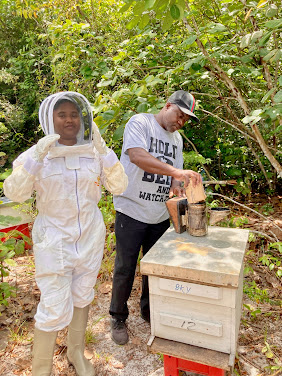Partners of the Americas and Farmer-to-Farmer: An Overview
This article is a contribution to a week-long blog carnival on USAID's John Ogonowski and Doug Bereuter Farmer-to-Farmer (F2F) Program. From July 14-18, F2F program partners and US volunteers are sharing their knowledge and experience of providing technical assistance to farmers, farm groups, agribusinesses, service providers, and other agriculture sector institutions in developing and transitional countries. This blog carnival aims to capture and share this program experience. You can find all contributions on Agrilinks.
At a glance:
 |
| Apiculture project in Haiti |
Partners of the Americas is a non-profit, non-partisan organization operating through the Western Hemisphere. Partners implements programs in a wide range of technical areas, including education, health, climate change, youth employment, sport for development, anti-child labor, and more. Partners has implemented agriculture and food security program for 23 years in 24 countries in Latin America, the Caribbean, and Africa. Partners' recent Farmer-to-Farmer programs have focused primarily on the Caribbean Basin, particularly in the Dominican Republic, Guatemala, Haiti, and Nicaragua.
Where did it come from?
Partners of the Americas was inspired by President Kennedy and founded in 1964 under the Alliance for Progress. The Partners Network is an international grassroots organization comprised of volunteers and development professionals who are devoted to building north/south partnerships.
What are its goals?
 |
| F2F Volunteer Tom Syverrud working with farmers in Nicaragua |
Partners of the Americas aims to connect people and organizations across borders to serve and to change lives through lasting partnerships. It contributes to global nutrition security and livelihood development by building productive partnerships and increasing the capacity and productivity of individuals and businesses.
How does it do it?
Partners brings many strengths to agriculture, food security, and economic growth programs, including: (1) a focus on small- and medium-scale producers and enterprises; (2) a market-led approach for agricultural programs; (3) capacity building and business skills development; (4) an extensive network of specialized volunteers; (5) an emphasis on building productive partnerships between the public and private sectors in order to provide access to information, technology, and new opportunities.
What are some of its successes?
· The Haiti Coffee project works with farmers to improve their coffee production and marketing skills. Through dedicated F2F volunteers and local partners, the project has grown to include coffee farmer associations across northern Haiti and has inspired the launch of HaitiCoffee.com, Inc.
· In the Constanza Valley in the Dominican Republic, F2F volunteers used Google Earth tools and smartphones to map the locations of susceptible crops and were able to measure the incidence of thrips and TSWW in the area. They presented the valley-wide data to stakeholders to help develop a long-term pest management plan.
· In Nicaragua, F2F volunteer have help build the capacity of local farmer Erenda Lopez and through her ElCentro de Aprendizaje Pio XII, she is sharing that experience and training others.
As aligned with Feed the Future, the U.S. Government's global hunger and food security initiative, F2F works to support inclusive agriculture sector growth, facilitate private sector engagement in the agriculture sector, enhance development of local capacity and promote climate-smart development. Volunteer assignments address host-led priorities to expand economic growth that increases incomes and improves access to nutritious food. Read more articles on this topic on Agrilinks. Also, make sure to subscribe to receive a daily digest in your inbox, for one week only!




.png)
Comments
Post a Comment